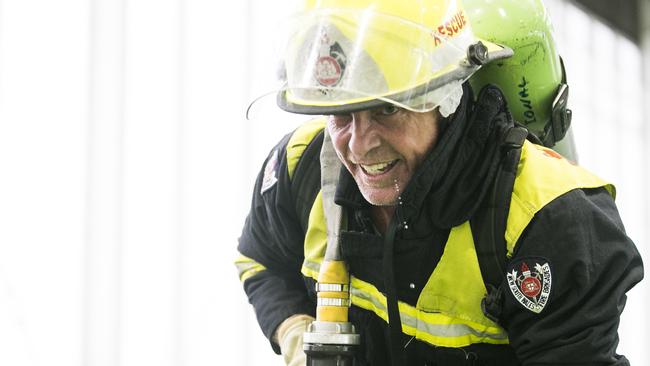Baptism of fire: How tough do you have to be to become a firefighter?
THEY’RE everyday heroes, saving lives while putting their own at risk. But how tough do you have to be to become a firefighter? Sunday Telegraph reporter Jack Morphet found out the hard way.
NSW
Don't miss out on the headlines from NSW. Followed categories will be added to My News.
AS I lurchingly reached for the conveniently-placed vomit bucket, I realised I probably should have thought twice before agreeing to try out for the fire brigade.
Sweating puddles in my fire protection suit, gloves, hat and boots as I lugged hoses, jerry cans and dumbbells around a specifically-designed course, the comfort of my air-conditioned office and cushioned chair seemed to be calling me.
Or maybe that was just the instructors waiting for me to collapse.
Luckily, pride was my one saving grace in the fiery furnace of the Blacktown International Sportspark, where the next generation of wannabe firefighters was put through their paces.


I had a long-lens camera trained in my direction and I had to write a story about it for a national audience. Failure was not really an option so I dug deep. Very deep.
After scraping through by the barest margins, I was the only applicant in the otherwise distinguished field who needed to be helped out of their uniform.
And what had I learned as I lay panting, dreaming of water fountains and vowing to never do something so foolish again? For those aspiring firefighters attracted to the hours, decent pay and regular rushes of adrenaline be warned: you’re in for a baptism by fire.
200 WOULD-BE fireys were last month put through a gruelling 17-minute fitness test designed to test their strength and stamina, known as the Physical Aptitude Test (PAT).
While most applicants showed incredible feats of strength in their bid to join the brigade, even the most hardened gym junkies can go to water when their core temperatures are pushed to 40C.
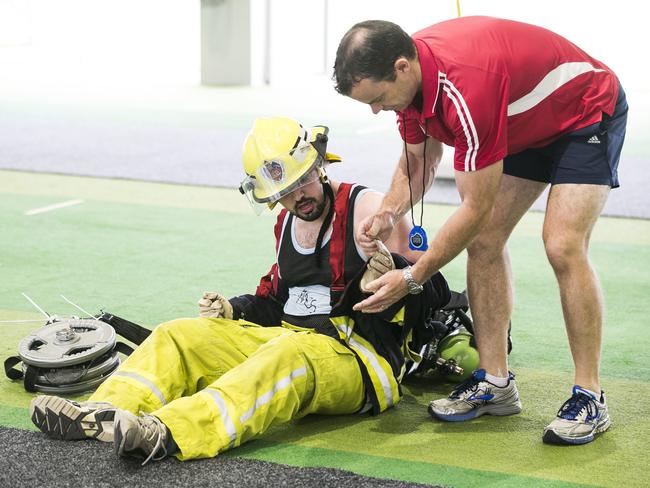
A firefighter’s tunic withstands roaring flames and protects against steam burns, but the trade-off is a scorching and stifling “microclimate” under the zipper.
“We have guys that are absolute weapons in the gym that can lift massive weights, work incredibly hard and puff like crazy in an air-conditioned gym but when you add the heat variable they gas out,” FRNSW team leader of health and fitness, Mark Gabriel, said.
According to Mr Gabriel, who holds an honours degree in science with a specialty in anatomy and biomechanics, exercising in a firefighters’ suit is the equivalent to cranking up the airconditioning in a hatchback already straining under the weight of towing a caravan uphill.
“With the aircon going you’ve got to go down a gear, rev harder and the engine struggles, which is what we see with some candidates,” he said.
An active tradie who works outdoors has a better shot than a sculpted poser.
With lives on the line, a crack team of exercise physiologists spent three years designing a course to test whether someone’s got what it takes to pull a body from a blazing inferno or cut a road crash victim from a crumpled wreckage.
My alarm bells immediately started going off when applicants were told to see a doctor before committing to the endurance test, given participants regularly submit to exhaustion and require treatment from paramedics.

Lugging 20kg of protective clothing, including an oxygen tank and ankle weights that come to feel like lead boots, you begin by donning a helmet with a blacked-out face-shield.
Running your left hand against an office wall, candidates have to circumnavigate the room on their hands and knees while avoiding obstacles like cricket stumps and desk chairs to prove they’re not claustrophobic or prone to panic.
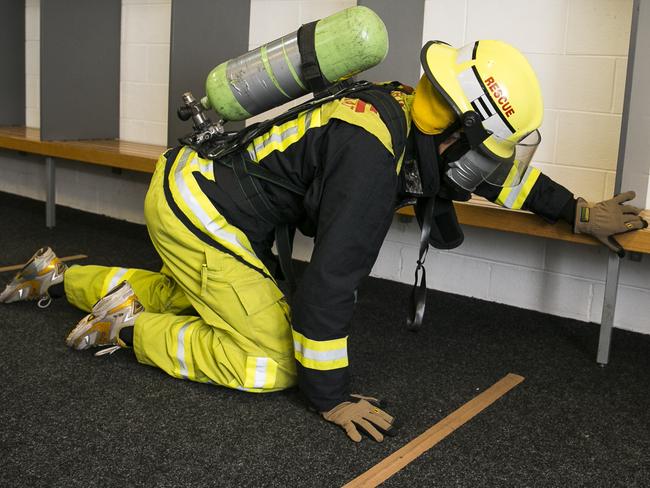
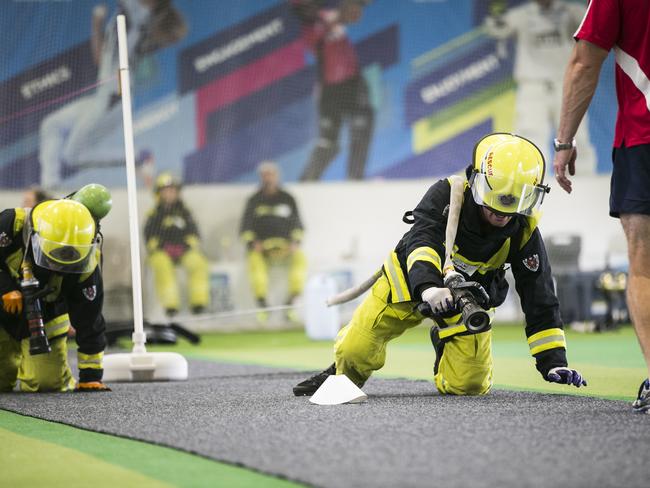
With the heart rate claiming, it’s on to the usual Cricket Practice Centre home to the Sydney Thunder, where ball machines make way for fire hoses hooked to marlin fishing reels with the exact tensile strength to mimic real-life action.
Beside each fishing reel is a vomit bucket.
Timed tasks include dragging hoses, lugging jerry cans filled with rocks and water, and holding aloft dumbbells the weight of Jaws of Life rescue shears, which cumulatively take a heavy toll on applicants like Simone Conden.
The 32-year-old mother-of-two with a light, five-foot frame, failed at the first hurdle, which is to clean and jerk 42kg — the force required to hoist a standard-issue ladder.

“I could lift the ladder in training without the gear, but the heavy tank on my back put me off balance, which is a bummer,” she said.
The same number of men and women are recruited to the fire brigade since a gender quota took effect in 2016, but only 38 per cent of women make it through the physical test compared to 98 per cent of men.
Chief Superintendent operational staffing and recruitment, Wayne Phillips, is a dogged defender of the gender quota, claiming diversity is vital to effectively engaging with the community, but made no bones about requiring women to lift the same weights the men do.
“We’re not taking women for women’s sake, this is not a box-ticking exercise, everyone has to pass the same physical test,” he said.
“I am 100 per cent confident the female firefighters we have can do the job because female firefighters have been doing the job since 1984.”
When Chief Supt Phillips joined the brigade looking resplendent in a woollen outfit with shiny brass buttons, he remembers a “uber-ly blokes club” where a candidate’s aptitude depended on height and chest expansion.
Things have definitely changed.
Amateur triathlete Ellyse Turner, 37, who turfed in her old job in the family landscape gardening business and breezed through the fitness challenge, fits the bill.
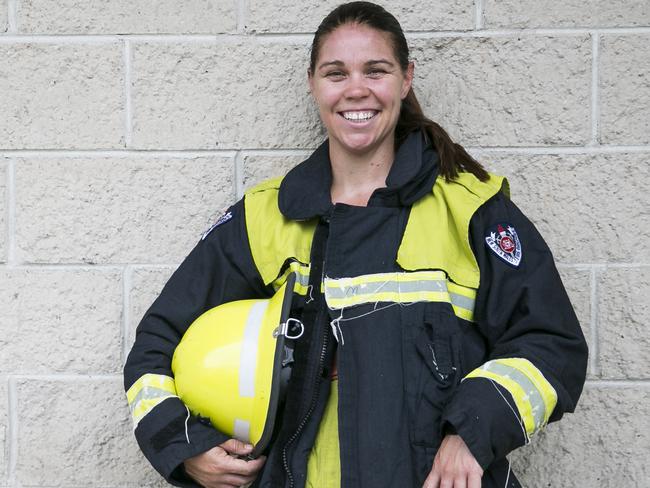
“I want a family, which is a challenge because smoke and fire retardant foam is not good for pregnant women, but everyone I’ve spoken to in the fireys say it’s a great career path for women and they’re very flexible,” she said.
“The main part of a firey’s job is communicating with people at what could well be the worst time in their life, so how are you supposed to relate, support or give advice to them if everyone’s got a single point of view?”
A touch more than 6800 people this year applied to join the fire brigade, which was whittled down through intellectual and emotional intelligence tests to just 200.
Seventy contenders failed the physical test, leaving just 130 high achievers vying for a formal interview in a fortnight.
The best of the best will be sent to FRNSW State Training College at Erskine Park in April for 13 weeks of intensive training to officially become card-carrying firefighters.
Thankfully for Sydneysiders, I won’t be one of them.

